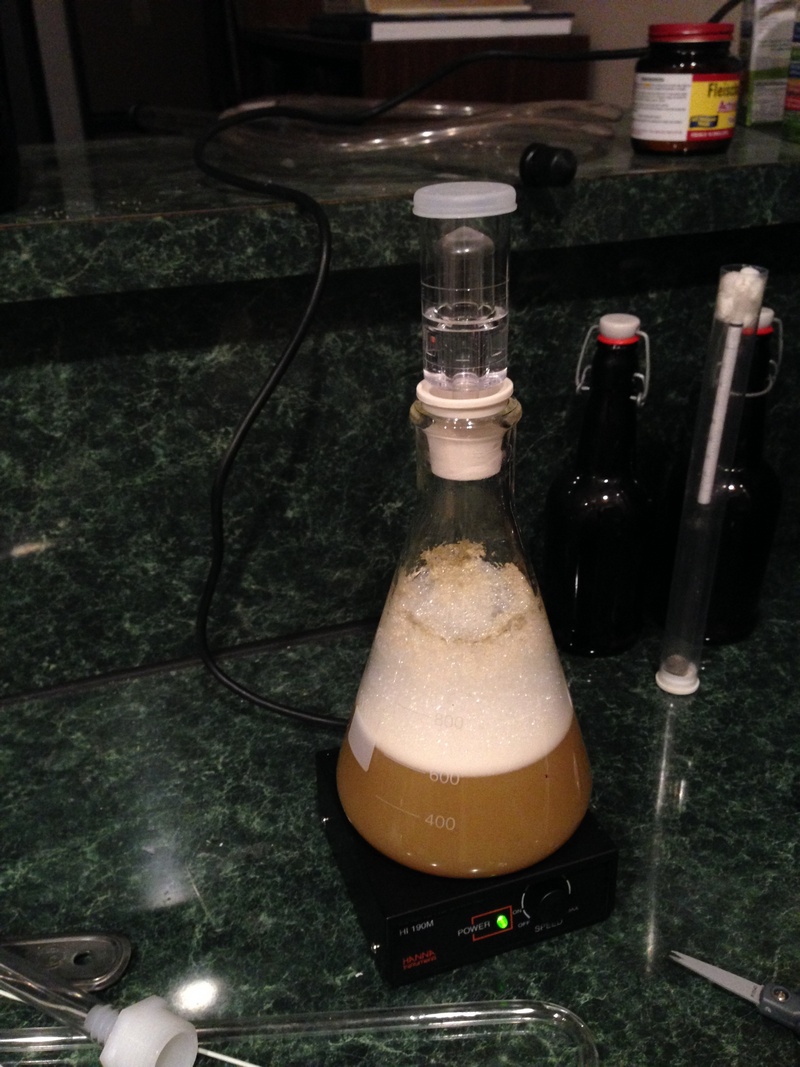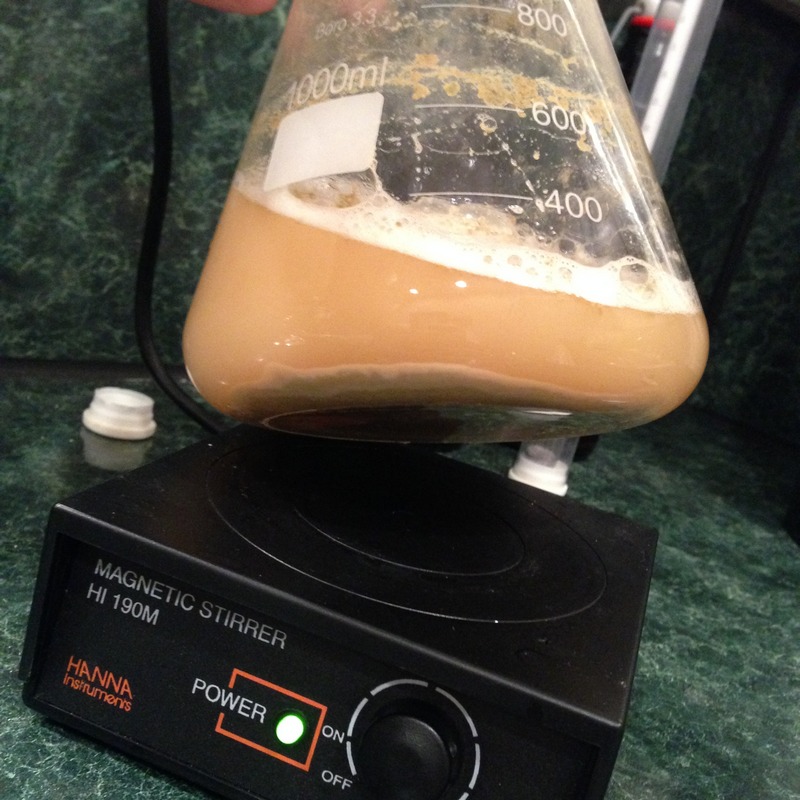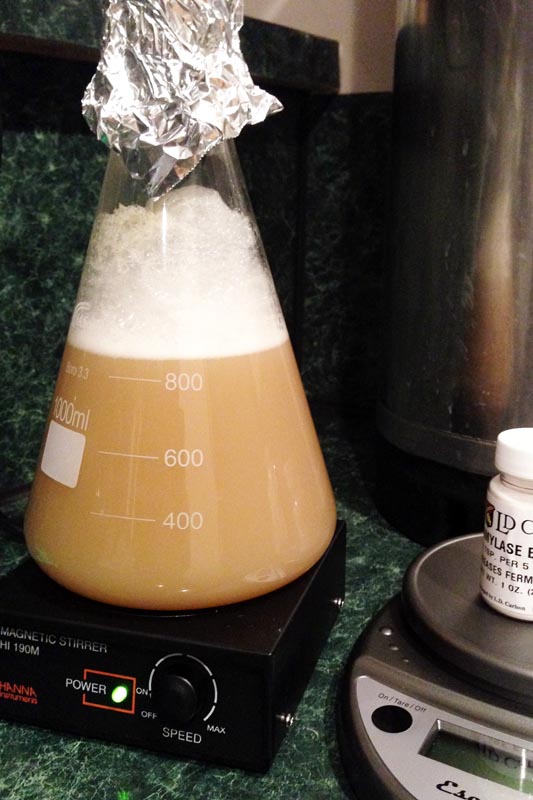I found an old thread about tasting/drinking wort during high krausen. This is when the yeast activity and concentration is very high. Some commentators expressed concern about gastrointestinal issues of consuming high-concentration yeast. This led me to Saccharomyces Boulardii, a known probiotic with health benefits. So I cooked up a brew.
0.75 cups of pilsner DME
800 mL water
A few pellets of Celia bittering hops
1 hour boil
Pinch of yeast nutrient
Immersion cool to ~55F
Rack 600mL into Erlenmeyer flask (200mL cold break left in brew pot)
One capsule of Florastor
Magnetic stir for 24 hours
Cold crash at 72 hours
Final Gravity test at 5 days (after 24 hours of cold crash)
The ratio of 0.75cu DME to 800mL water is roughly equal to 1.25lbs/gallon for ~1.050 OG. Since my batch was only 800mL, I did not take an OG reading. After 12 hours on magnetic stir, high krausen was already subsiding (attached photo). The stirrer was turned off at 24 hours. After 48 hours, some very fine sediment was forming (attached photo).
Notes:
12 hours: Krausen was already subsiding. Tasted 50mL. Fizzy, very yeasty taste, moderately dry.
24 hours: Krausen absent. Turned off stirrer. Tasted 50mL. Fizzy, very yeasty taste.
48 hours: Very fine, powdery sediment. Tasted 50mL. Fizzy, very yeasty taste.
96 hours: Stir plate turned off. Cold crash started in refrigerator.
+24 hours: Final gravity measured: 1.024. Yeast sentiment rinsed to use for next experiment.
Conclusion:
Florastor tablets contain a lyophilized (freeze-dried) strain of Saccharomyces Boulardii that has fast attenuation and very low flocculation. It has a very yeasty taste, perhaps to the low flocculation and suspended yeast. Attenuation stopping point (1.024) signals the yeast stops after simple sugars. My Celia hops were old with a strong grassy/wet hay character that masked much of the yeast's possible flavor contributions. This yeast might be applicable to a Brandenburg countryside hefeweizen or an early/authentic Berliner Weisse recreation.
I've started a follow-up experiment, using 800mL water 120g DME with amylase enzymes to simplify sugar content for lower final gravity.



0.75 cups of pilsner DME
800 mL water
A few pellets of Celia bittering hops
1 hour boil
Pinch of yeast nutrient
Immersion cool to ~55F
Rack 600mL into Erlenmeyer flask (200mL cold break left in brew pot)
One capsule of Florastor
Magnetic stir for 24 hours
Cold crash at 72 hours
Final Gravity test at 5 days (after 24 hours of cold crash)
The ratio of 0.75cu DME to 800mL water is roughly equal to 1.25lbs/gallon for ~1.050 OG. Since my batch was only 800mL, I did not take an OG reading. After 12 hours on magnetic stir, high krausen was already subsiding (attached photo). The stirrer was turned off at 24 hours. After 48 hours, some very fine sediment was forming (attached photo).
Notes:
12 hours: Krausen was already subsiding. Tasted 50mL. Fizzy, very yeasty taste, moderately dry.
24 hours: Krausen absent. Turned off stirrer. Tasted 50mL. Fizzy, very yeasty taste.
48 hours: Very fine, powdery sediment. Tasted 50mL. Fizzy, very yeasty taste.
96 hours: Stir plate turned off. Cold crash started in refrigerator.
+24 hours: Final gravity measured: 1.024. Yeast sentiment rinsed to use for next experiment.
Conclusion:
Florastor tablets contain a lyophilized (freeze-dried) strain of Saccharomyces Boulardii that has fast attenuation and very low flocculation. It has a very yeasty taste, perhaps to the low flocculation and suspended yeast. Attenuation stopping point (1.024) signals the yeast stops after simple sugars. My Celia hops were old with a strong grassy/wet hay character that masked much of the yeast's possible flavor contributions. This yeast might be applicable to a Brandenburg countryside hefeweizen or an early/authentic Berliner Weisse recreation.
I've started a follow-up experiment, using 800mL water 120g DME with amylase enzymes to simplify sugar content for lower final gravity.






